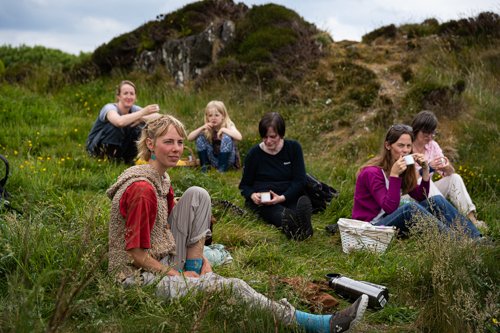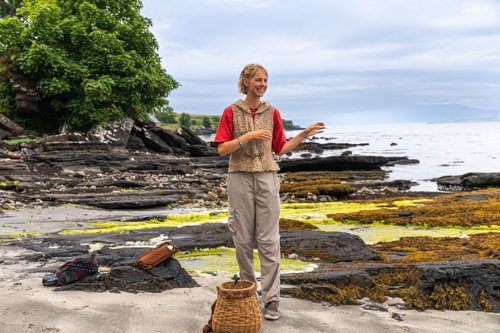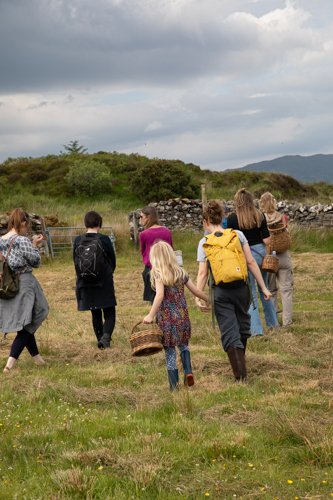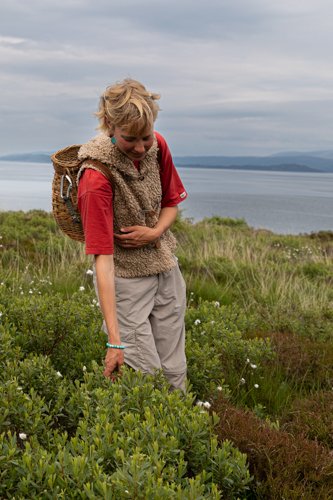It is almost mid summer and the hedgerows and meadows are thick with vegetation. The mountain slopes surrounding Broadford Bay have lost the bleak brown of winter. The land is now carpeted in green and the sea is deep blue. We are blessed with warm air and bright sunshine for our forage along the path that meanders along to Irishman’s Point.
Ten of us have assembled to join Jemima Hall, artist, forager and educator of ancestral skills to learn more about a selection of edible plants, their use and history.
Jemima begins by reminding us our ancestors were hunter gatherers and foraging would have been a major part of everyday life. Foraged foods provided the protein, carbohydrate, fats, vitamins and minerals essential for life. She explained that foraging is seasonal and follows a pattern. In the spring when green shoots appear our ancestors would foraged in hedgerows and grassland for leaves and roots. They would then moved on to the shoreline for sea weeds, shellfish and fish and in the autumn the woods would have provided nuts, a rich source of energy dense fats and protein. Nuts could also be stored to be eaten when fresh food was scarce.
We begin our forage. The first plant Jemima pauses to consider is wild garlic, which looks like it has gone over. Well yes, the leaves and flowers have, but the seeds are just beginning to form on the spherical head of the flower. She gathers some seeds, tries them, describes the intense garlic flavour and we do the same. I take a tentative nibble and the flavour of garlic explodes in my mouth. This is garlic on steroids! The seeds can be eaten as they are or preserved in vinegar or, lacto-fermented like kimchi. Useful for scattering over salads or dotting on Mediterranean or Middle Eastern dishes.
We wander on. Our next stop is alongside a stand of vicious looking stinging nettles. The leaves of young nettles are highly prized for soups. Jemima explains their sting can be neutralised by heat or by crushing.
Nettles have another use. Their rough outer ‘bark', can be used to make a strong twine for use in tying back plants or even woven into rough cloth or a mat. Jemima demonstrates the easiest way to remove the stinging leaves is by holding the nettle in the fold of her t-shirt and then stripping the leaves from the stem. She then opened up the stem with a finger nail and stripped out the inside leaving the fibrous outer bark. She stretched the fibres tight to demonstrate their strength.
Wild sorrel was next on our list. Standing about 30cm from the ground it’s thin apricot seeded head attracts a number of birds including red polls. But what we are looking for are the spear like, dark green leaves which grow from the base of the stem. We all pick some leaves, assemble in a circle and present the leaves to Jemima for her to check we have picked the correct ones. We have a nibble. The leaf tastes acidic. Like lemon but not lemon. Sorrel leaves contain high levels of oxalic acid and as Jemima points out should only be eaten in small quantities. Sorrel leaves come in handy if you don’t have any lemon and your cooking requires an acidic note.
We continue walking and nibble on white clover, although red clover has more health benefits, and blackberry leaves. Soon we arrive at bog myrtle. A shrub that covers large swathes of acidic heathlands in the north of the UK. Squash its young leaves between your fingers. They feel resinous and have a distinctive smell.They can be used in tea, soups and stews. Traditionally they were used in beer making before the widespread use of hops. I liked the smell of these.
Moving on Jemima points out meadowsweet. This fragrant plant has a long history of culinary use. It gets its name from mead, the fragrant honey-wine. Meadwort, or Medwort, was one of fifty ingredients in a drink called ‘Save’ mentioned by English author Geoffrey Chaucer in a Knight’s Tale.Today, meadowsweet is one of thirty herbs and spices added to the popular Norfolk punch cordial drink, originally made by the monks of Norfolk, England. I pick some leaves and save them to make a cup of tea later.
The walk is nearing the end but there are two other plants we take a closer look at. Ribwort plantain and silverweed. I take a tentative nibble on the furry head of the ribwort plantain. I am not convinced it is edible at which point Jemima pipes up to say “if I am on a walk and feel hungry I often snack on ribwort plantain heads’. For a woman who has spent a month existing on the remote Shiant Islands I can believe it.
We do not try silverweed but are told the root is a rich source of carbohydrate and was a vital source of energy to remote communities during periods of food shortage. On some islands silverweed and shell fish was all there was to eat.
All good walks should end with a cup of tea and ours was no exception. Jemima unpacked a large flask of hot water from her wicker basket, gave us each a tiny enamel mug and instructed us to place a few leaves of our foraged herbs into the mug before pouring over the boiling water. We allowed the herbs to steep in the hot water and the session ended with questions and getting to know more about the other people in the group. It was a great forage and lovely to meet Jemima. She is a foraging star!
The walk was organised by The Selkie Collective, Broadford. For more information about their events www.theselkiecollective.com
For more information about Jemima www.jemimaelisabethhall.com










